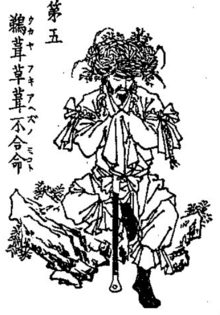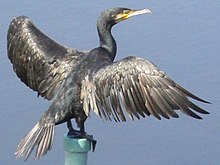Ugayafukiaezu
| Ugayafukiaezu | |
|---|---|
 | |
| Personal information | |
| Parents | Hoori (father) Toyotama-hime (mother) |
| Consort | Tamayori-hime |
| Children | Emperor Jimmu |
Ugayafukiaezu no Mikoto (鵜葺草葺不合命)[1] is a Shinto kami, and is in Japanese mythology, the father of Japan's first Emperor, Emperor Jimmu.[2]
Nomenclature and story[]

In the Kojiki, his name appears as Amatsuhiko Hiko Nagisatake Ugayafukiaezu no Mikoto (天津日高日子波限建鵜葺草葺不合命),[1] and in the Nihon Shoki as Hiko Nagisatake Ugayafukiaezu no Mikoto (彦波瀲武鸕鶿草葺不合尊).
Ugayafukiaezu was a child of Hoori, the son of Ninigi-no-Mikoto, who was sent down by Amaterasu to govern the earth (Ashihara no Nakatsukuni) (believed to be equivalent to Japan), and of Toyotama-hime, a daughter of Ryūjin, the dragon kami of the sea.[2]
Although Toyotama-hime became pregnant at the undersea palace of Ryūgū-jō, she opted not to bear the child in the ocean and decided to head to shore.
On the shore, her parents attempted to build a house in which she could give birth, and attempted to construct the roof with feathers of the cormorant instead of saw grass. However, while they were finishing the roof, she went into labor.
And so just as she was about to give birth, she spoke to her husband, saying:
"When their time draws near, people of other lands all give birth in the form of their homeland. So I will now give birth in my original form. Please, I beg you, do not look at me!"
Now, thinking these words strange, he sneaked up and peered in at her just as she was about to give birth.
She had become an enormous sea beast many arm spans in length that was twisting and slithering around on its stomach.
In shock and fright at the sight of her, he immediately fled far away.[1]
In shame, Toyotama-hime fled, leaving behind her newborn, whom she called Ugayafukiaezu.[1]
Later, when Ugayafukiaezu reached adulthood, he married his aunt, Tamayori-hime, and they had four children: Hikoitsuse, Inai, Mikeirinu, and Hikohohodemi (later Emperor Jimmu).[1]
Mikeirinu traveled to Tokoyo, the "Everworld", and Inai went into the ocean to be with his mother. The eldest and youngest set forth to rule the land and while they did so together for a time, after Hikoitsuse died, their youngest became the first ruler.[1]
References[]
- ^ Jump up to: a b c d e f Ō no Yasumaro; Heldt, Gustav (2014). The Kojiki : an account of ancient matters. ISBN 9780231163897.
- ^ Jump up to: a b "鵜葺草葺不合命" [Ugayafukiaezu]. Kokushi Daijiten (in Japanese). Tokyo: Shogakukan. 2012. OCLC 683276033. Archived from the original on 2007-08-25. Retrieved 2012-12-04.
External links[]
- Japanese gods
- Shinto kami

